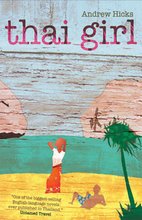
Mangorn and Mali make an offering for the new harvest.

Gong, Nan and Gi at their new school.
Our village far out on the rice plains of North Eastern Thailand has a cosy little school which I always enjoy visiting. With about ninety five children and classes of only ten it may be poor in material terms but it has a wonderful caring atmosphere. It’s a happy place the kids will remember all their lives and it doesn’t matter much if it fails to turn them into academic giants.
I often ask myself what the objective of education in schools such as this one should be anyway. Basic literacy and numeracy are essential but any striving for greater achievement will only take the children away from the village as there are simply no opportunities here.
If you want to get ahead you have to get away, rejecting the simple life of the rice farmer. Agriculture offers few rewards and so education is the answer for those who want to escape the rice fields. Ironically a really good school would thus only wean its best and brightest away from the community and so perhaps contribute to its ultimate decline.
Nan, Cat’s sparky little cousin who lives with us has recently finished at the village school and we had a long debate about where she should go next. The normal progression is to a secondary school a few villages further up the road but Nan is an able child and perhaps worth something better. We wondered about a school in Surin town but decided that one of the two schools in nearby Sangkha would be a more practicable choice.
She and her friends in the top class went ahead and sat the entrance exam and all of them failed to win a place.
We piled them into the pickup and drove in to the school to get the results, full of anticipation and excitement. All was smiles and laughter as they hopelessly scanned the list for their names. Cat then found a school administrator sitting behind a big wooden desk and a long parley began. I was in the dark as always and the outcome emerged only after a matter of weeks.
It’s no secret around here that the way into a good school is money under the table, usually about 5,000 baht which is a tidy sum. An English teacher friend then told me they’re cracking down on this and that it might not be so easy to find a way in. This proved to be true but in a rather different way.
It was not 5,000 baht but three annual instalments of 8,000 baht that they were now asking for each child.
Whether this was regular or not I have no idea, but it all looked perfectly proper. From what Cat was telling me, the school was resisting making classes any larger by taking extra kids and so were creating new classes to absorb the high demand. This imposes additional costs and Cat was given a sheet on which all the figures were efficiently laid out. The cost of three extra classes divided by the number of heads came to about 8,000 baht a year each so that was the key to gain admission to the school.
It seemed cheap at the price and I was perfectly happy to stump up for Nan as she’s worth every satang spent on her education. My problem was that it didn’t stop there.
In my new book, MY THAI GIRL AND I ’ there’s a chapter about Cat’s older brother, Mangorn and his wife Mali and about their tough life raising a family. For me they personify the fine qualities of the Isaan farmer, working hard and intelligently for very little reward. The big hurdle for them is now the cost of education for Gi and Gong, their strapping non-identical twins.
As a family they are very resilient but sometimes there are set-backs. Recently their cow house burned down and one of the cows was killed. Gong broke his knee very badly while working in Bangkok in the school holiday and the operations cost them a small fortune.
Gi had been awarded a scholarship to go to a school that would qualify him to be a sports teacher as he was a talented Thai boxer and athlete. After less than a year he suffered a serious injury to his eyes and the whole thing came to an end.
Both boys were drifting and Mali wanted to get them into the same school as Nan in Sangkha to give them a better chance in life. For two boys the cost in fees, uniforms, food and transport was prohibitive and one that few ordinary rice farming families with little land could possibly manage.
They’re delightful young men, polite and handsome so how could I say no. My hand thus went into my pocket again and I paid the first year’s instalment for both of them. I now wonder about the future.
Cat is in full time education too, and with Nan and the two boys I now need to set up a charitable foundation specializing in education! My miniscule pension based on ten years’ service at a university in England certainly doesn’t stretch to paying for all of them and I have to stop shelling out somewhere.
Mangorn and his boys thus need a stroke of luck. Where can we find funds that will pay for a few years of education for these two talented young men and start them out in life?
I have no idea but I do know that they’re worth it.





No comments:
Post a Comment